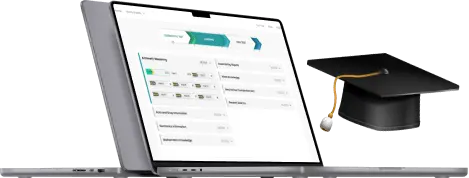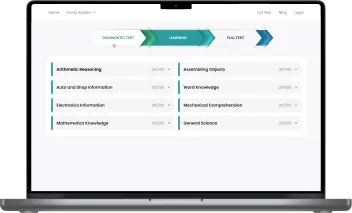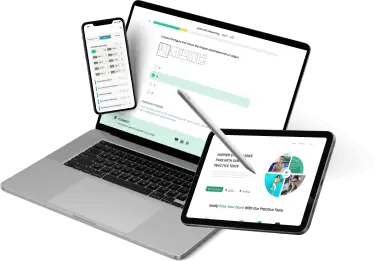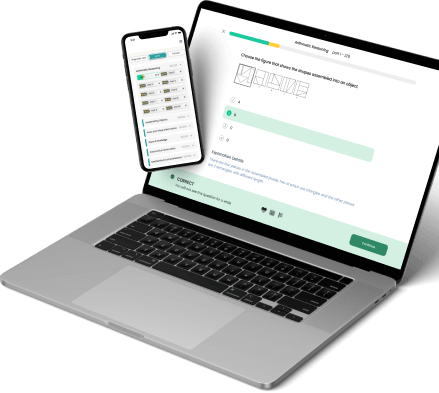Fun & effective ASVAB practice test tool to pass with flying colors
All-in-one platform with everything you need to ace the ASVAB on your first attempt
Clear and Thorough Learning Path
Proven ASVAB 3-step Practice Formula
After our 100,000+ users' success stories, we developed a 3-step strategy to provide you with the most precise and in-depth learning path while minimizing your prep time.ASVAB Diagnostic Test
First, take this short test and get your detailed report showing your strong and weak areas. Save your time by concentrating on what is in demand.Learning
With quick, bite-sized learning techniques and a detailed study guide for each ASVAB section, you can really strengthen your weaknesses (from step 1) and boost your scores.ASVAB Full Test
The last step for your preparation is taking our full ASVAB practice tests and seeing how far you've come since the beginning. Repeat the 3-step formula until you are satisfied with your results!Ready to start?
Thousands of ASVAB users already accomplished their goals.NOW it’s your turn!

What You Get

All-in-one platform
A complete ASVAB Prep Platform, including a diagnostic test, detailed study guides for all topics, practice questions with step-by-step explanations, and various full simulator tests.
Questions nearly identical to those in the real ASVAB test
All questions are categorized into the specific sections as on the real ASVAB: Same format & same difficulty!
Best for the busy
Easily & quickly grasp all the knowledge with our unique learning technique. And you can learn anytime, anywhere on any devices, even with a few free minutes.
Practice while having fun
Learn and play! Complete round-by-round to reach your daily achievement and make progress on your learning journey!Featured on















What our users are saying
Over 50,000 aspiring American candidates use ASVAB monthlyYou may have heard that completing the Armed Services Vocational Aptitude Battery (ASVAB) is the key to a successful career in the United States military. If you are considering entering the military, then it is time to get serious about taking the ASVAB by reading this article.
The Armed Services Vocational Aptitude Battery, often known as the ASVAB, is a multiple-choice exam that is used by the United States military to decide whether or not an individual meets the recruitment requirements necessary to join the armed services of the United States. This evaluation is open to everyone who has the credentials necessary to join the armed forces. Nonetheless, students may also start taking the ASVAB once they are in the tenth grade.
The Armed Services Vocational Aptitude Battery (ASVAB) is a test that is given out at Military Entrance Processing Stations (MEPS) and at select high schools. The ASVAB is used for two different objectives. The 1st step is to evaluate a person's mental capacity to see whether they are suitable for service in the armed forces. The 2nd reason is that the results of the mental aptitude test are used by the various branches of the military to identify which jobs within the military are suitable for placement.
ASVAB History & Use
The Department of Defense is the organization responsible for creating and maintaining the ASVAB. It wasn't until eight years later, in 1976, that the military started using the information for recruit placement after it had been produced in 1968. Since it was first developed, the ASVAB has seen just one major alteration.
The ASVAB consists of 10 different parts with multiple-choice questions, and the examinee is given a total of three hours to finish the test. The following are the 10 categories:
- General Science (GS)
- Arithmetic Reasoning (AR)
- Word Knowledge (WK)
- Paragraph Comprehension (PC)
- Mathematics Knowledge (MK)
- Electronics Information (EI)
- Auto Information (AI)
- Shop Information (SI)
- Mechanical Comprehension (MC)
- Assembling Objects (AO)
The findings of the ASVAB are included in studies conducted by the Department of Defense of the US. The results of the test are sent to various institutions and military recruitment.
How Many Questions on the ASVAB?
The ASVAB that is administered through a computer contains a total of 145 questions, while the ASVAB that is administered via paper includes 225 questions. Both versions of the ASVAB are broken down into a variety of distinct subtests, each of which has a unique quantity of questions that must be answered within a certain amount of time. When taking the ASVAB on a computer, these subsections may be completed at the test taker's own leisure, and the vast majority of people finish the full exam earlier than the given amount of time.
Paper-based tests, by contrast, are paced by a teacher by the allotted amount of time for each component; this is the primary reason why paper-based exams take much more time to finish. The data shown in the tables below may be used to compare the 2 different iterations of the ASVAB in terms of the questions included in each subtest.
Computer-based ASVAB Test
|
Section |
Questions |
Time |
|
General Science |
16 questions |
8 minutes |
|
Arithmetic Reasoning |
16 questions |
39 minutes |
|
Word Knowledge |
16 questions |
8 minutes |
|
Paragraph Comprehension |
11 questions |
22 minutes |
|
Mathematics Knowledge |
16 questions |
20 minutes |
|
Electronics Information |
16 questions |
8 minutes |
|
Auto Information |
11 questions |
7 minutes |
|
Shop Information |
11 questions |
6 minutes |
|
Mechanical Comprehension |
16 questions |
20 minutes |
|
Assembling Objects |
16 questions |
16 minutes |
|
Total |
145 questions |
154 minutes |
Paper-based ASVAB Test
|
Section |
Questions |
Time |
|
General Science |
25 questions |
11 minutes |
|
Arithmetic Reasoning |
30 questions |
36 minutes |
|
Word Knowledge |
35 questions |
11 minutes |
|
Paragraph Comprehension |
15 questions |
13 minutes |
|
Mathematics Knowledge |
25 questions |
24 minutes |
|
Electronics Information |
20 questions |
9 minutes |
|
Shop Information |
25 questions |
11 minutes |
|
Mechanical Comprehension |
25 questions |
19 minutes |
|
Assembling Objects |
25 questions |
15 minutes |
|
Total |
225 questions |
149 minutes |
Paper-based and computer-based versions of the ASVAB are meant to test the same information. This means that an individual's score normally should not change regardless of whether they take the computer-based or paper-based version of the exam.
The flexibility of the computer-based test is one of the key distinctions between both two formats. This variant of the test allows the participant to tailor their experience to the degree of difficulty of the questions they are being asked by presenting them with questions that are either simpler or more difficult depending on whether or not they have answered a previous question correctly.
What Does The ASVAB Cover?
The 10 subtests that make up the ASVAB are broken down into 4 distinct testing divisions.
Mathematics
A person's ability in mathematics may be evaluated using one of two different exams. One of them is called the Arithmetic Reasoning (AR) exam, and its primary emphasis is on solving word problems. The other exam is called the Mathematical Knowledge (MK) test, and it is meant to assess a person's ability to execute mathematical functions as well as exhibit knowledge of the mathematical concepts and processes that they might have learned about throughout their time spent in school.
Science and Technical
The Mechanical Comprehension (MC) exam is used to evaluate a candidate's aptitude for mechanical work, whilst the Shop Information (SI) test evaluates a candidate's level of knowledge of various kinds of instruments and terminology pertinent to the industry. In the Automotive Information (AI) exam, candidates are quizzed on their level of expertise in many aspects of automobile engineering. The Electronics Information (EI) test evaluates an individual based on how much they know about electronics and the way electricity works. Understanding the fundamentals of function and physical science is the primary subject of the General Sciences (GS) course.
Verbal
The two tests that are used to measure a person's level of verbal ability are called Verbal Word Knowledge (WK) and Paragraph Comprehension (PC). The Word Knowledge exam is designed to evaluate a candidate's capacity to comprehend words in the context in which they are used. The reading comprehension portion of the PC exam is given the most weight.
Spatial
The ability to predict how a whole thing will appear based on its pieces is the primary focus of the Assembling Objects (AO) exam.
What are the ASVAB Requirements?
Those persons who are qualified to join the military are the only ones who are permitted to take the ASVAB. A military recruiter is the one who decides whether or not an application meets all of the requirements. The applicant will be scheduled to take the ASVAB as soon as the military recruiter has concluded that the applicant satisfies the fundamental admission conditions.
Age Requirements
There are age requirements that must be met to enlist in every branch of the military. Individuals as young as 17 years old are eligible to enlist, however, those who are under the age of 18 at the time of their enlistment are required to get parental approval in the form of a signed document.
Active duty candidates for the Army may join up until they become 35 years old. For those interested in entering the Marine Corps, the minimum age requirement is 29, whereas the Navy accepts active personnel up to the age of 34. Applicants for active duty positions in the Air Force may join the service up to the age of 39, making it the service with the highest admittance age. The US Coast Guard has the youngest age limit for candidates; the service does not accept anybody older than 27 years old.
The age requirements for Army and Marine Corps reserves are the same as their age limitations for candidates interested in active service, whereas the age requirements for Navy reserves range from 18 to 39 years old. When a person reaches the age of 38, they are no longer eligible to join the reserves in the Air Force, but the Coast Guard allows individuals to join the reserves up to the age of 39.
Standards for Minimum Physical Fitness
To serve in the armed forces, potential recruits need to demonstrate that they are physically fit. When deciding whether or not an individual is suitable for a career in the military, their height, weight, and overall physical condition are taken into consideration. Candidates are required to complete a physical examination.
Citizenship Requirements
Documentation is necessary for individuals to provide to demonstrate that they are either citizens of the United States or permanent residents of the United States.
Academic Requirements
To be eligible for service in the armed forces, one must possess either a high school diploma, a General Educational Development (GED), or another certificate that is recognized as being equivalent to a high school education.
ASVAB Scores
10 separate subtests make up the ASVAB, and each one has its own score. Candidates get their results for each of these subtests through the ASVAB Student Results sheet immediately after the exam. The military takes the individual results and combines them into two distinct sorts of composite scores: the Armed Forces Qualification Test score and the line scores.
The score on the Armed Forces Qualification Test (AFQT) is equivalent to what is required for admittance through the Armed Services Vocational Aptitude Battery (ASVAB). This score is calculated by how well a person does on four of the ten different subtests that are included in the ASVAB. Those assessments are as follows:
- Arithmetic Reasoning (AR)
- Mathematical Knowledge (MK)
- Paragraph Comprehension (PC)
- Word Knowledge (WK)
A percentile score is assigned to each examinee after the outcomes of the exam have been gathered. This indicates that a person's AFQT score cannot be lower than 1, and that the maximum score they may earn is 99. The score was determined by comparing the results of the exam that the student took in 1997 to those of a sample group in 1997. If you got a score of 37, it indicates that you performed at the same level or higher than 37 percent of the persons who took part in the sample from 1997.
How is the ASVAB Score Calculated?
The ASVAB score calculators that are accessible online may be used to determine the ASVAB scores for the various branches of the armed forces, including the AFQT score. The first thing that has to be done is to determine one's AFQT score, which is the total of one's results on the AFQT subtests.
After this step, the line scores from the remaining subtests are put together, and the final scores are then calculated for the various branches of the armed forces. The final recruiting decisions are made based on a combination of the results obtained from the AFQT and its many subtests.
What is a Passing Score on the ASVAB?
You need to get a score that is equal to or higher than the average score achieved by people taking the exam who have the same level of ability as you. The Item Response Theory (IRT) scoring method is what determines how applicants at a particular level of ability will score on the ASVAB. This system assesses the likelihood of how candidates will score on the exam. The questions in the examination are tailored to the specific degree of knowledge possessed by the examinee.
Your result will be compared to a standard score to get an idea of how well you performed. This standard score represents the amount of standard deviation by which a score is either higher than or lower than the mean value that has been established.
The standard deviation of the ASVAB subtest scores is 10, with the mean score of each test coming in at 50. If you scored a 30, for instance, this indicates that your standard deviation was 2 units (measured in 10s) lower than the mean. On the other hand, if you get a score of 60 on the exam, it places you one standard deviation above the mean.
You will obtain a score on the AFQT in addition to the one you receive on the ASVAB. The results from the first four parts of the AFQT are averaged to determine a candidate's fundamental knowledge, while the remaining subtests are intended to determine a candidate's potential for success in a certain line of work.
What is the Average ASVAB Score?
10 different exams make up the ASVAB. A standardized score is assigned to each of these subtests, and it is derived from the results of a sample of people who took the exam all throughout the country. A benchmark score of 50 or above is required to pass each component of the ASVAB exam, which is achieved by about half of all examinees. A score of sixty or above is achieved by less than 20 percent of those who take the examination. As a result, the typical score on the ASVAB is 50.
What is the Minimum ASVAB Score for the Military?
The results of the ASVAB are not included in the recruitment process. When candidates are being allocated to different occupations within the armed forces, the results that they received on the various subscores of the ASVAB are taken into consideration.
Your results on the AFQT, on the other hand, will determine whether or not you are eligible for enlisting. The minimal score on the AFQT that is required for entry into each branch of the military is not the same. There is not one that requires a score that is higher than the 50th percentile. The following are the minimum AFQT scores that are necessary for the various branches:
- Air Force: 36
- Army: 31
- Coast Guard: 50
- Navy: 35
- Marine Corps: 32
How are Military Jobs Assigned Based on ASVAB Scores?
A method known as classification is used to determine which military profession is best suited for each individual who is eligible for service. During this stage of the examination, several composite scores are determined by combining the results of various ASVAB subtests. Only the subtests that are most relevant to each department's job responsibilities are merged, and this process is repeated for each department.
When calculating the composite scores, each service employs its one-of-a-kind algorithm. The applicants' overall scores are included in the determination of which jobs are best suited for them.
What Happens if You Fail the ASVAB?
Examinees have the opportunity to retake the ASVAB if they did not pass or score well. Despite this, the ASVAB adheres to a stringent standard regarding the amount of time between retakes. Candidates are required to wait at least a month before trying to retake the ASVAB after they have completed the original exam. Second testing requires a waiting time of one month, whereas a 3rd retest requires a waiting period of 6 months.
How to Prepare for the ASVAB Exam?
To get the best possible result on any test, preparation is very necessary. Your performance on the ASVAB will affect the branch of service you choose. You may strengthen your knowledge base by studying English, physics, and mathematics at a recognized high school or college to prepare for the related subtests. This will allow you to establish a firm foundation for your knowledge. You would also benefit from taking technical classes so that you are more acquainted with the subtests that are more directly connected to your career.
Check out the ASVAB Practice & Study Guide if you want to get a comprehensive understanding of the ASVAB. This resource walks you through every aspect of the test by providing you with complete transcripts as well as video lessons. If you have any problems comprehending the content, you will also have the option of seeking assistance from a remote teacher. There is also a final practice test, in addition to practice quizzes, for you to take so that you may perfect your abilities.
The viewing and answering of example questions from the ASVAB is an additional useful method of preparation. On the official website of the ASVAB, you can get free examples of questions from the examination. These practice questions will help you get familiar with the organizational structure of the examination, which is an additional advantage.
You will be able to select in advance, with the assistance of this information, whether you would want to take the written P&P ASVAB exam or the computer-administered CAT-ASVAB version of the test. You must get a sufficient amount of sleep not just during the time that you are studying but also the night before the test.
How to Register for the ASVAB?
An ASVAB participant must first register with a military recruiter to take the exam. They will make arrangements for qualified applicants to take the ASVAB there if an MEPS is situated close to the applicant's domicile. If there isn't a Military Entrance Processing Station (MEPS) in the candidate's area, the military recruiter may be able to sign them up to take the test at a satellite Military Entrance Test (MET) location instead.
People should first choose the branch of the armed forces in which they are interested in serving before getting in touch with a recruiter since each branch of the armed forces has its own set of recruiters. Information about the different choices and branches of the military may be found in a variety of online places (www.todaysmilitary.com).
Our ASVAB practice tests
Free Practice Questions: 850+ free ASVAB practice questions with detailed explanations are available for all of the required skills. All you need to pass your recruitment test is available here.
ASVAB Practice Tests Based On Real Tests: Same number of questions, same time limits, same structure. The exam simulators let you familiarize yourself with the test format and get totally ready for the real one.
No Sign-Up Or Login Required: All of your progress is saved without an account, even if you close your browser. But login can sync your data between web and mobile applications.
Gamification: The learning process will be divided into small milestones. Let’s make your studying exciting as if you were in some interesting games.
Personal Study Plan: Just enter your ASVAB test date, and a study plan will be set up for you. A clear schedule will surely exceed your expectations and get you the best preparation for the reading shot.
3 Interesting Test Modes: 3 different test modes with increased difficulty levels let you experience the ASVAB practice test in various ways.
Dark Mode: Experience a dark theme that is more friendly to your eyes, and get a whole new and marvelous experience.
No Internet Required: Study on the go conveniently without any Internet connection.
ASVAB Test Bank: 3 features: Weak/ Medium/ Strong questions help you clearly determine which area you should pay more attention to.
FAQs About ASVAB
How Hard is the ASVAB?
Military recruits are evaluated using the Armed Services Vocational Aptitude Battery (ASVAB) exam to identify their suitability for certain career choices within the various branches of the armed forces. Because the ASVAB assesses a wide variety of spatial, mathematical, scientific, and technical skills and knowledge, the degree to which it will be difficult for any test-taker to pass will depend, in part, on how adept they are at taking tests, how well they understand the material that is being tested, and how well they are able to switch focus while the test is being administered.
Is It Allowed to Use a Calculator on the ASVAB?
No aid from other sources is allowed during the administration of the ASVAB, including the mathematical sections of the test. Consequently, the use of a calculator during the ASVAB test is not allowed under any circumstances.
How Much Does the ASVAB Cost?
Candidates for a military position are exempt from having to pay any kind of examination fee. Even while you may pay for programs to help you prepare for it, the exam itself is completely free to take. The price of preparation programs might range anywhere from $100 to $500, depending on the school you attend and the kind of education you pursue.
What Subjects Should I Focus on?
The official ASVAB testing organization recommends that you have a strong foundation in the subjects of science, mathematics, and English. It is possible that taking technical classes would be beneficial while preparing for the ASVAB sections on mechanical comprehension and electrical knowledge. Even if many of these subjects are covered in high school, it is still a good idea to analyze your knowledge and determine the areas in which you need further work before the test.
How Often Can I Take the ASVAB?
To retake the ASVAB test, you will need to wait one full calendar month following your first attempt. You need to wait one more month per the calendar before you can retake the test. After that, you are required to wait the equivalent of six calendar months before retaking the ASVAB. Your test results may be used to enroll in the military for up to two years following the date of the exam.
When Will I Receive My ASVAB Scores?
The results of the ASVAB examinations that were taken at the Military Entrance Processing Station are made available in what is essentially real-time. The outcomes of the pencil-and-paper tests that are part of the Career Exploration Program, on the other hand, could not be provided to the test takers for up to three weeks.
How Long are ASVAB Scores Good for?
Your scores on the ASVAB will be considered valid for a maximum of two years, even if you decide against joining the military. On the other hand, after you've joined the military, your previous test results will remain valid for as long as you continue to serve.
Are you interested in joining the Military? If the answer is Yes, don’t forget to consider the ASVAB. This can be regarded as a door to the development of your career. Good luck!






